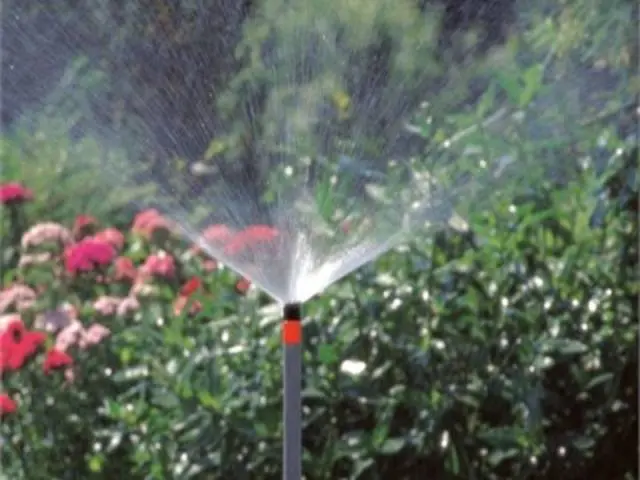Contents
Raspberry is a deciduous, slightly thorny shrub with a perennial rhizome. Biennial erect stems grow in height from 1 m to 2,5 m. Among many species, raspberry Caramel is distinguished by large fruits, weighing about 8 g.
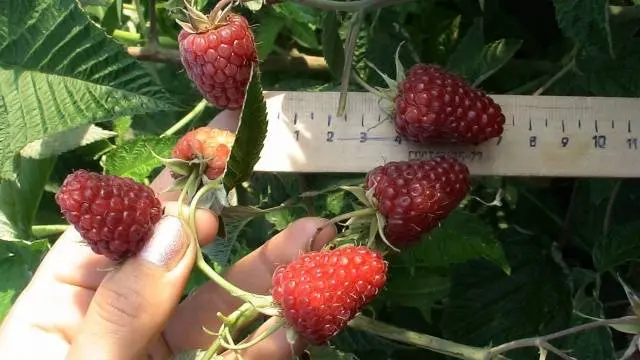
Cone-shaped berries are distinguished by sweet and juicy pulp and, due to their dense structure, perfectly tolerate transportation. Since the stalks are separated simply, the collection of Caramel raspberries is not difficult.

Depending on the region, the bush begins to bear fruit from the end of July – the beginning of August. According to the characteristics, Caramel is one of the sweetest remontant varieties.
Planting rules, soil requirements
You can plant Caramel raspberries before the start of the growing season in the spring – in March, or already in the fall, closer to the beginning of October.
When choosing the location of the Caramel raspberry, one must take into account the need for good lighting. Usually summer residents plant raspberries behind buildings. In this case, you need to choose a site under the walls on the south side, which will additionally protect the plants from strong gusty winds. For planting Caramel, both large and small areas can be allocated.
Particular attention should be paid to the “history” of the earth. You can plant raspberry bushes after onions, carrots, beets, lettuce or dill.
Landing stages
- Holes are dug with a size of 56×60 cm and a depth of about 40 cm. 2 tbsp can be poured onto the bottom. l. superphosphate.
- Before planting, it is recommended to put Caramel seedlings in water in which the root formation stimulator is diluted.
- Raspberry seedlings Caramel are placed in the hole and buried. When planting, the root neck should be flush with the ground.
- The distance between the bushes in a row is 70-90 cm. For the aisle, a strip of earth 1,5-2 m wide is left. If you adhere to such a raspberry seating pattern, the bushes will be better ventilated.
When planting and caring, it must be borne in mind that this raspberry variety grows well on loose, rich lands. Therefore, it is recommended to fertilize the soil with compost. Approximate consumption – from 2 to 3 buckets of organic matter per 1 sq. m. From inorganics, it can be advised to use the mineral complexes “Kemira”, “Ecofosk”.
Features of care
Thanks to proper maintenance of the bushes, it will be possible to harvest an excellent harvest (as in the photo).
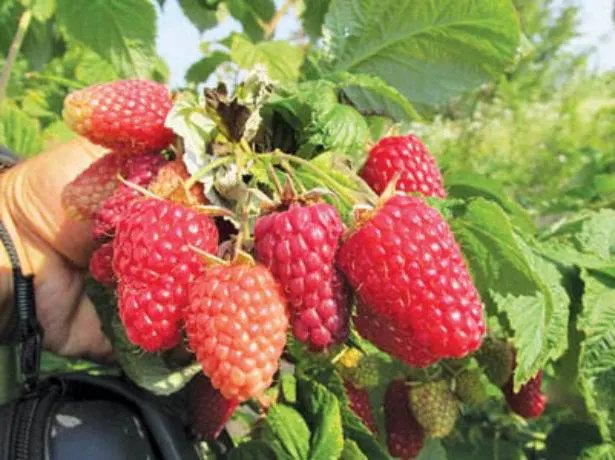
Watering
The optimal watering of the plant is once every two to three weeks. Moreover, for one raspberry bush Caramel requires at least 5-9 liters of water. Plants require the most moisture during flowering and berry ripening. It is advisable to mulch the ground under the bushes and nearby with straw or mowed grass.
There are several ways to water raspberry varieties Caramel:
- sprinkling – refers to the most popular, especially in areas of unstable moisture. Water is sprayed as rain over the surface of the earth and raspberry bushes. Racks are fixed between rows, and sprayers should be above the level of plantings. Advantages of the method: channels and furrows do not form on the soil, the earth is moistened evenly (which is especially important in areas with difficult terrain), the structure of the earth does not collapse, dust is washed off the leaves and their respiration improves. In cloudy weather, watering Caramel can be carried out at any time of the day. And on hot sunny days, it is advisable to irrigate raspberry bushes in the evening. With this method of irrigation, it is important to choose the right match between the intensity of rain and the speed of water absorption into the ground. The disadvantages include deterioration in the quality of irrigation with strong winds or a decrease in water pressure in the system;

- irrigation systems are equipped with hoses and allow water to be delivered directly to the ground next to the raspberry stalks. Advantages of the method: watering raspberries Caramel can be carried out at any time of the day, even with a small pressure of water in the system. The disadvantages include: the formation of a crust on the surface of the earth, the uneven distribution of water on the site (especially on the slopes), the leaching of nutrients from the upper layer of the earth, the deterioration of the water-air regime of the soil.
Feeding raspberries
Three times the application of fertilizers to the ground is considered optimal.
The first time Caramel raspberries are fed at the end of March. Both organic and inorganic fertilizers can be used. Manure is diluted in water at a ratio of 1:10 and is used at the rate of 4-5 liters of solution per square meter. For mineral dressing of raspberry bushes Caramel, ammonium nitrate is mixed with urea (15 g and 10 g, respectively, per square meter). The mixture is poured around each bush, then the raspberries are watered and mulched.
The second time the bushes are fed during the flowering period of raspberries. To make a solution in 10 liters of water, dilute 2 tbsp. l. potassium sulfate and 3 tbsp. l. double superphosphate. This volume is enough for a square meter of soil.
The third stage is the feeding of raspberries Caramel in the fall after harvest. In 10 liters of water add 1 tbsp. l. potassium sulfate and 2 tbsp. l. superphosphate.
Rules for garter and pruning
This shrub stands out with strong stems. But due to the weight of the fruit, they are able to lean strongly towards the ground. Tying the stems will not only facilitate harvesting, but also contribute to better ventilation of the bushes. Due to uniform illumination, Caramel raspberries will ripen faster and the likelihood of developing fungal infections will decrease.
For tying the stems, a trellis method is used. Pillars are installed along the bushes at a distance of 3-4 m from each other. Supports about 2 m high are dug in to a depth of 50 cm. A wire is attached to the poles, which is pulled at levels of 70, 100, and 150 cm. Caramel raspberry stalks are tied to the wire as they grow.

In early spring, raspberry Caramel releases new shoots. To prevent the stems from becoming crowded, the shrub is thinned out. In April, the shoots are cut to the first bud.
During June, summer pruning of Caramel raspberries is carried out in order to remove excess root shoots. Weak stems should be removed at the base with a pruner.
In October-November, it is desirable to cut off the ground part of the Caramel raspberry. In autumn, plant nutrition stops, the leaves fall off and only raspberry roots remain for wintering. If the stems are not removed, they are tied up, tilted to the ground and fixed. And do not wait for the complete fall of the foliage. Raspberries should be worked on while the stems are still green and flexible enough. If the bush is covered with agrofiber, then Caramel will remain even at temperatures below 22˚ C.
Harvesting and growing raspberries
Berries begin to sing from the end of July – the beginning of August. With good care, about 5 kg of berries can be removed from the bush. It is better to harvest in the afternoon, carefully examining each bush. Caramel sings gradually, so it is better to leave pink fruits to ripen.
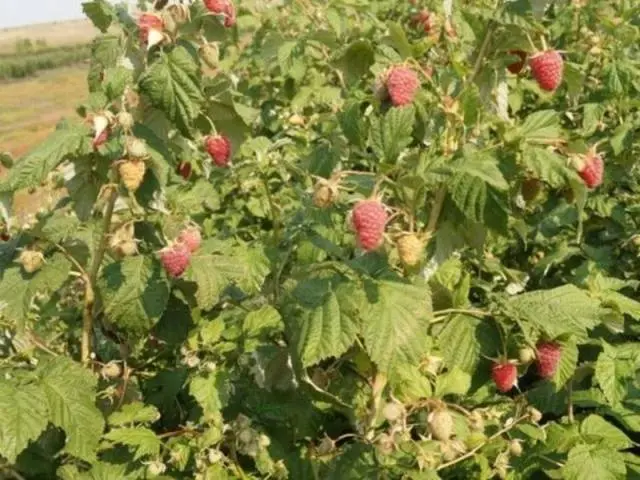
When describing raspberries Caramel, one of the ways to breed it should be highlighted separately. Using conventional techniques may not work for a remontant variety that produces few shoots. You can use the method in which stems are cut in the spring or autumn, located in the center of a two-year-old raspberry. The next season, raspberry Caramel releases new offspring, which are suitable for seating.
Diseases and pests of raspberries
When growing a bush, it is taking care of it, timely prevention of diseases and protection from pests that will help you constantly harvest a good harvest.
Common diseases, methods of treatment and prevention
Anthracnose is a fungal disease of raspberries that manifests itself in the form of brown spots on the leaves. After some time, the affected area increases and spreads to the stems and berries, depressions form on the surface of the foliage. Spread by seeds, insects, stem cutting devices. Raspberry treatment Caramel – spraying the bushes with copper sulphate, oxychom, vitriol.
Spotting (purple, white, ulcerative) – damage to the bush by a fungus. Purple, brown spots appear on the leaves, which then affect the stem. If the disease is not fought, then the entire raspberry bush dies. The disease develops rapidly in spring and early summer. Therefore, before bud break, it is recommended to spray raspberries with a 7% solution of urea. The main cause of the disease is very dense raspberry bushes.
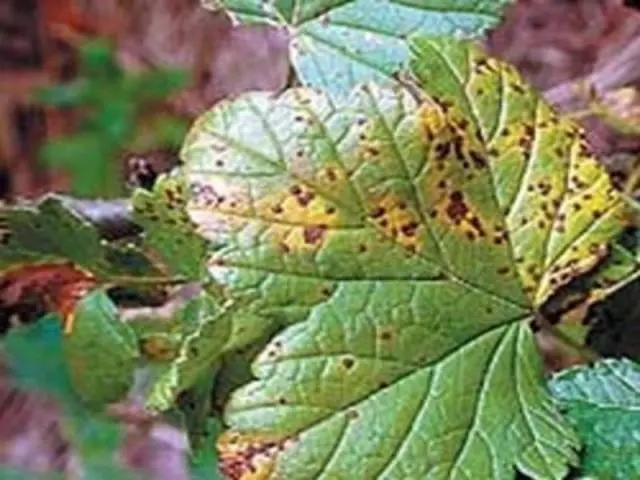
Common preventive measures to reduce the chance of infection include:
- timely fertilization of the land for the purpose of proper nutrition of the shrub;
- pruning of stems (sanitary and seasonal). Especially carefully it is necessary to cut dry and old shoots;
- cut raspberry stalks are burned;
- weeding;
- regular loosening of the earth around the raspberry Caramel to a depth of 5 cm;
- periodic irrigation of bushes with vegetable infusions from harmful insects.
The main pests of raspberries
Raspberry mite that damages the leaves. You can prevent the spread of the pest by spraying the bushes with a solution of copper sulfate, and the procedure is carried out before the buds open.
Aphids settle on the underside of raspberry leaves and are especially dangerous as a carrier of various diseases. If the pest is seen on single bushes, then you can try to wash it off with a pressure of water from a hose. Treatment with chemical agents effectively helps: Aktara, Inta-vir, Kinimix. Before using chemicals, carefully study the instructions from the manufacturers.
Raspberry glassware has the appearance of a butterfly with transparent glassy wings. Caterpillars hibernate inside the shoot and begin to eat it away with the beginning of spring. Damaged stems of raspberry bushes Caramel have a swollen appearance, bear little fruit, dry out and break even at the base. The best means of struggle is careful cutting of damaged stems (almost under the root), damaged stems must be burned.
The raspberry bud moth damages the buds of the bushes, as a result of which the raspberry leaves do not develop. Protection measures include low cutting of damaged stems. If cases of damage are not isolated, then it is recommended that the bushes be treated with insecticides.
Conclusion
Raspberry Caramel is a relatively new variety that is quickly becoming popular. Delicious fruits with the aroma of wild berries will delight summer residents until autumn with proper care of the bushes.
Reviews of gardeners
I was surprised by the yield of Caramel raspberries – very worthy. The berries are of a decent size, excellent taste – no worse than Polkka. So far I haven’t found any cons.










